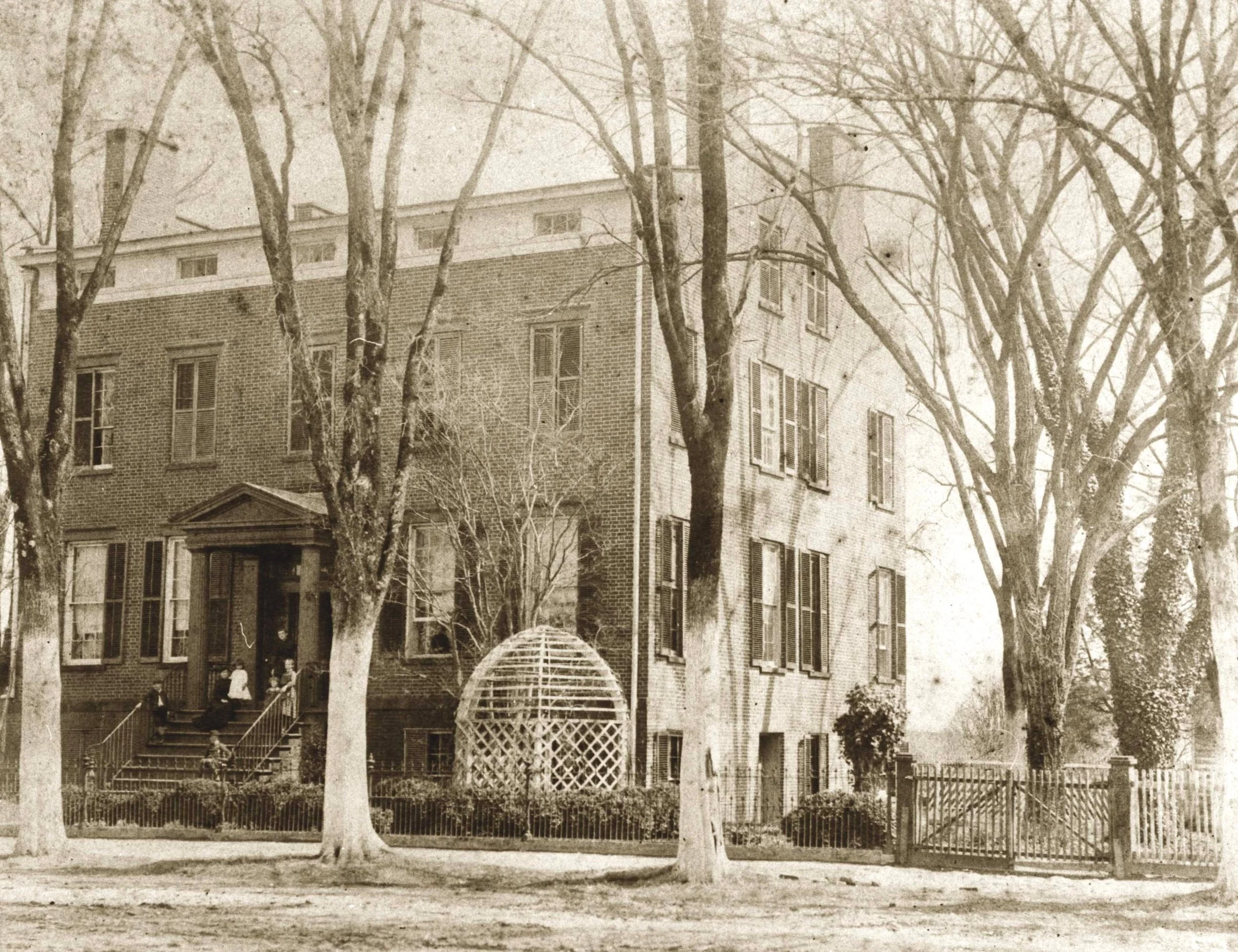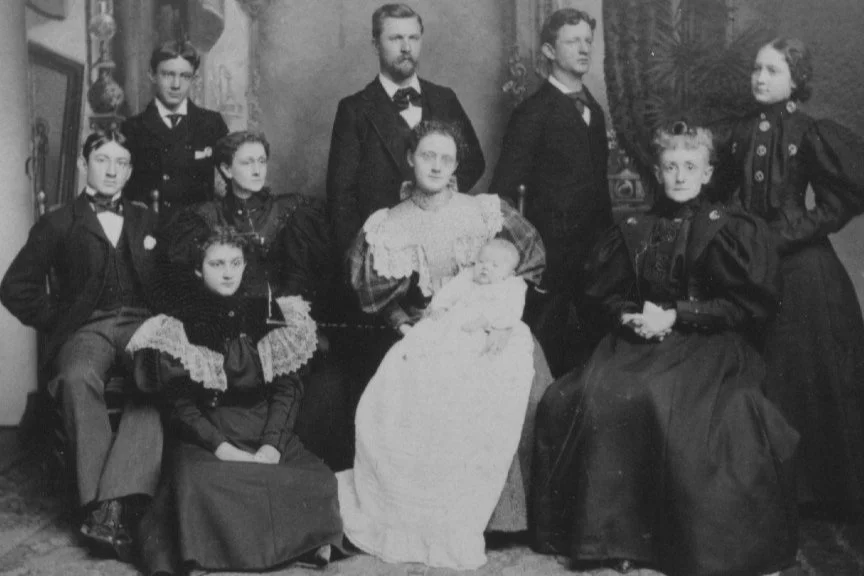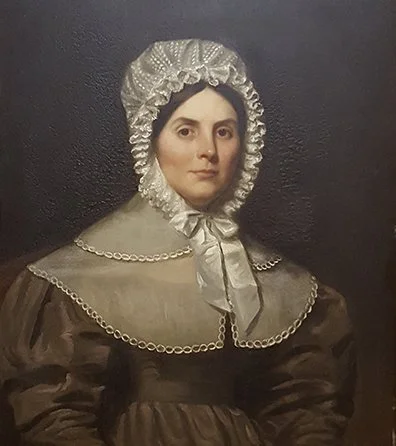Welcome to Riddick’s Folly
History
Riddick’s Folly in 1882
While Mills Riddick’s contemporaries may have mocked his Greek Revival home when it was built in 1837, the house now stands as a beautiful reminder of the past.
This most impressive structure on Main Street in Suffolk features striking architectural details. The five frieze band windows across the front of the house are rarely seen in eastern Virginia. The front of the mansion is bricked in Flemish bond, and double chimneys rise from both ends of the stately historic landmark. Slender columns of the Greek Revival period frame the main entrance. The interior showcases intricately carved, gilded moldings and elaborate ceiling medallions throughout the main floor of the house.
Riddick’s Folly has four floors, twenty-one rooms, and sixteen fireplaces. All four floors are open to the public. The building features elegantly furnished double parlors, a gentlemen’s library, and adult and children’s bedchambers, as well as a bathing and dressing room on the third floor, slave quarters on the fourth floor and the winter kitchen which is housed in the English basement along with the laundry and dining rooms. We also have a tastefully stocked Gift Shop in the English basement which was once the larder or pantry. Upcoming projects include restoring portions of the carriage house and outside fencing.
In early 1837 a fire ravaged dozens of homes and outbuildings at the north end of Main Street in Suffolk. Out of the ashes of that fire Mr. Mills Riddick built their home that is known today as Riddick’s Folly. Mills Riddick was a member of a large and prominent family in Suffolk and Nansemond County. He was the grandson of Revolutionary War hero Col. Willis S. Riddick and was a captain of cavalry during the War of 1812. In 1819 and 1829 he served as a member of the Virginia House of Delegates, representing Suffolk and Nansemond County.After the death of Mills Riddick, in 1844, his son Nathaniel became head of the household and lived here with his wife, Missouri, and their five children until the Civil War. During the Union occupation of Suffolk the house served as headquarters of Major General John J. Peck and his staff of Union Army officers. Penciled messages left on the walls by Union and Confederate soldiers are still legible today. When the family returned 3 years later, they found their home stripped of most of their possessions.Riddick descendents continued to live in the home until 1967 when the house and grounds were sold to Nansemond County for use as office space. In 1977, Riddick’s Folly was established as a facility for cultural events in Suffolk. In 1988 and 1989 the house underwent an extensive privately funded restoration and became Suffolk’s only house museum and is continually being enhanced by the acquisition of period furnishings, ongoing research, and further restoration.
Research
The Riddick’s Folly archives contain an impressive 8,000-piece collection of family correspondence dating from the 18th century, and genealogical records have traced the Riddick line as far back as 14th century Scotland. We continue to transcribe the Riddick’s Folly’s archives and at a future date they will be available for non-lending use only.
Please contact the museum office at 757-934-0822 for more information.
These are some descendants of Mills & Mary Taylor Riddick
Baptismal photo from 1896 of Missouri Taylor Riddick Withers and Family — Pictured here standing left to right: John Thornton Withers, Arthur Woolford (husband to Zouzie Withers), Nathaniel Riddick Withers, and Janet Alexander Withers. Seated, middle row left to right: Robert Walter Withers, Missouri Taylor Riddick Withers, Zouzie Withers Woolford (holding Austin Withers Woolford, first child of next generation), and Anna Mary Riddick (sister of Missouri). Seated, front row: Anna Chinn Withers
The Riddicks
Mills Riddick (1780–1844)
Mills Riddick (1780-1844) owned four plantations — Old Place, Sweet Retreat, Soldier’s Hope and Jericho — east of the town of Suffolk. In addition to these lands, he also owned stakes in the Albemarle Swamp Land Company and the Dismal Swamp Land Company. Mills Riddick made most of his personal fortune selling lumber, specifically cedar and cypress shingles, to Philadelphia and New York. He owned 3/4 of the stock in the schooner Washington docked at Constant’s Wharf in Suffolk that he used to transport his cargo.
Mills and Mary Taylor Riddick had fourteen children, ten who lived to maturity. In 1820 they moved from Old Place plantation to Main Street Suffolk with their children.
In 1837, a fire swept down Main Street and burned several of Mills Riddick’s buildings including his own residence. The insurance settlement, some $5,600.00, paid for the construction of his new Greek Revival home – Riddick’s Folly.
Mills Riddick lived at Riddick’s Folly a short five years. He died in the ladies parlor which is now the office for the museum’s staff. After his death, Mary Taylor choose to move to a smaller dwelling about one block south of their grand home. Riddick’s Folly fell to their ten children in equal shares until one of her younger sons, Nathaniel Riddick, purchased his siblings shares and owned Riddick’s Folly outright at the young age of 25.
Mary T. Riddick (1788–1875)
Nathaniel and his wife, Missouri Ann Jones Kilby Riddick, had moved into the house the same year his parents did in 1839. They had their first child, Anna Mary Riddick, in 1841 followed by five other siblings. Nathaniel was a lawyer with a growing practice that soon outgrew the gentlemen’s library which prompted him to construct a law office on the property in 1851. Nathaniel’s political reputation earned him 12 consecutive years representing Suffolk and Nansemond County in the Virginia House of Delegates. At the beginning of Civil War, in 1862, Nathaniel relocated his family to Petersburg, Virginia leaving his home to be taken by General John J. Peck as his Union headquarters. Nathaniel and his family returned to Riddick’s Folly in 1865 to find it looted and vandalized.
After the war Nathaniel still sought out a role in public life, serving as a judge in the town of Suffolk in the late 1870’s. He also was the mayor of Suffolk for seven years. He died in his law office in 1882.
The Riddick line in Suffolk broke up after Nathaniel’s passing; four of his five surviving children with the Riddick surname did not wed. Only his fourth child, Missouri Taylor Riddick Withers bore Nathaniel and Missouri’s grandchildren. The Withers, Woolfords, and Rollings resided in the home.
Nathaniel and Missouri’s oldest daughter, Anna Mary Riddick, continued living at Riddick’s Folly with her new relatives for another 50 years. She passed away in 1936 at the age of 95. She was the first child born in the home and the last person to die there.





